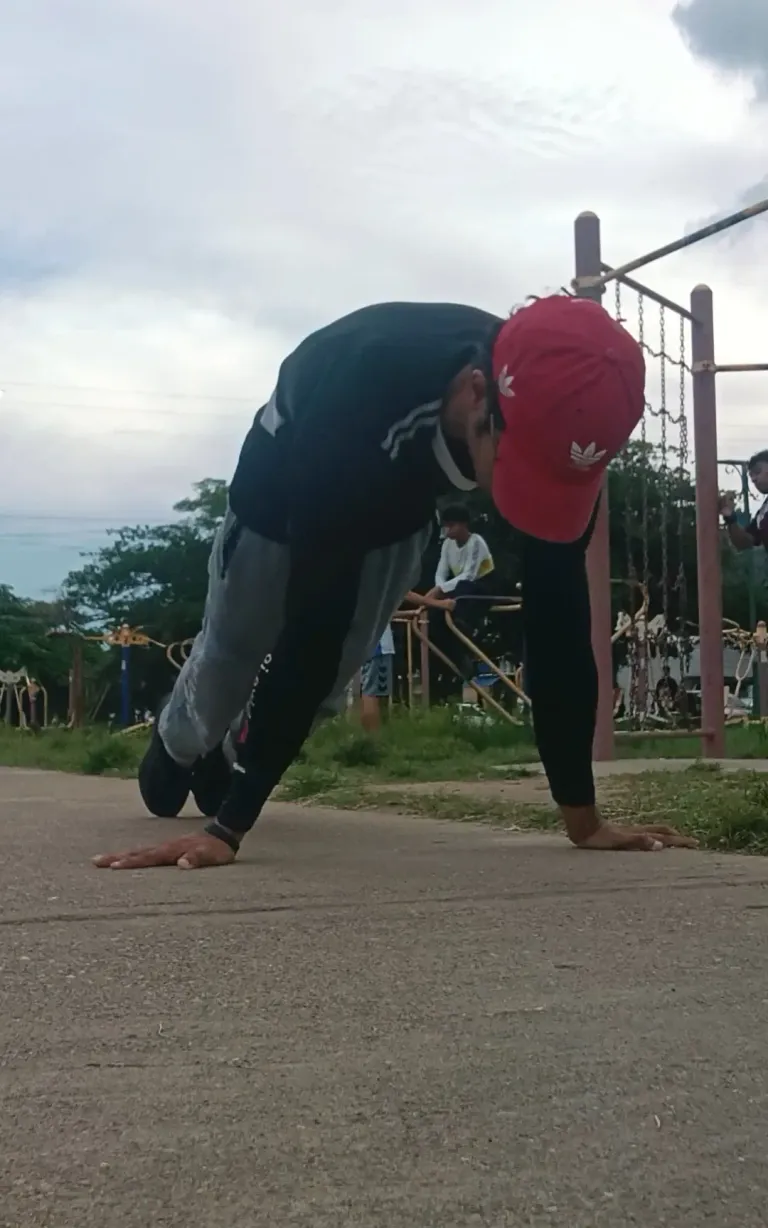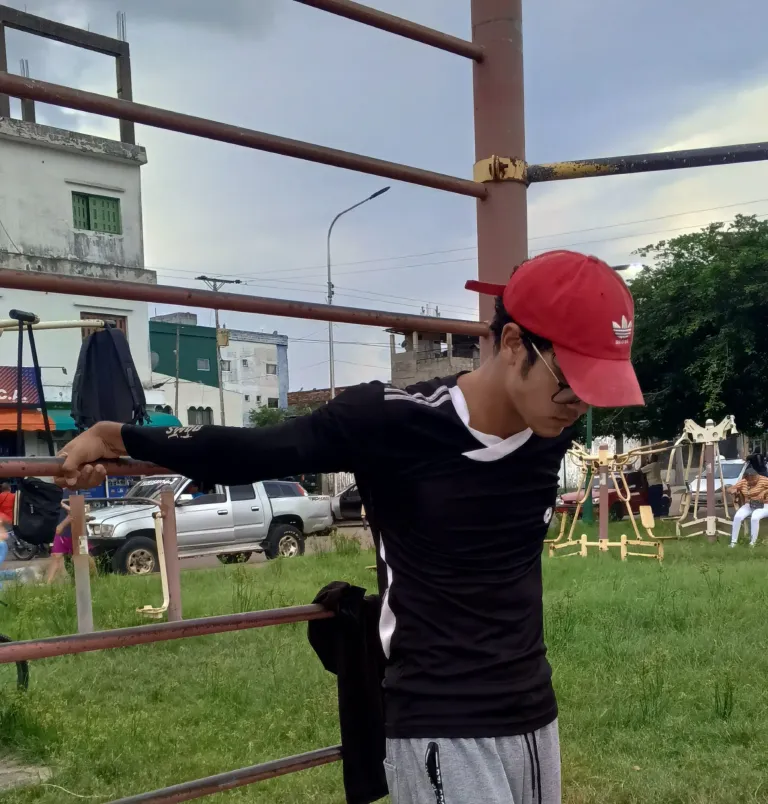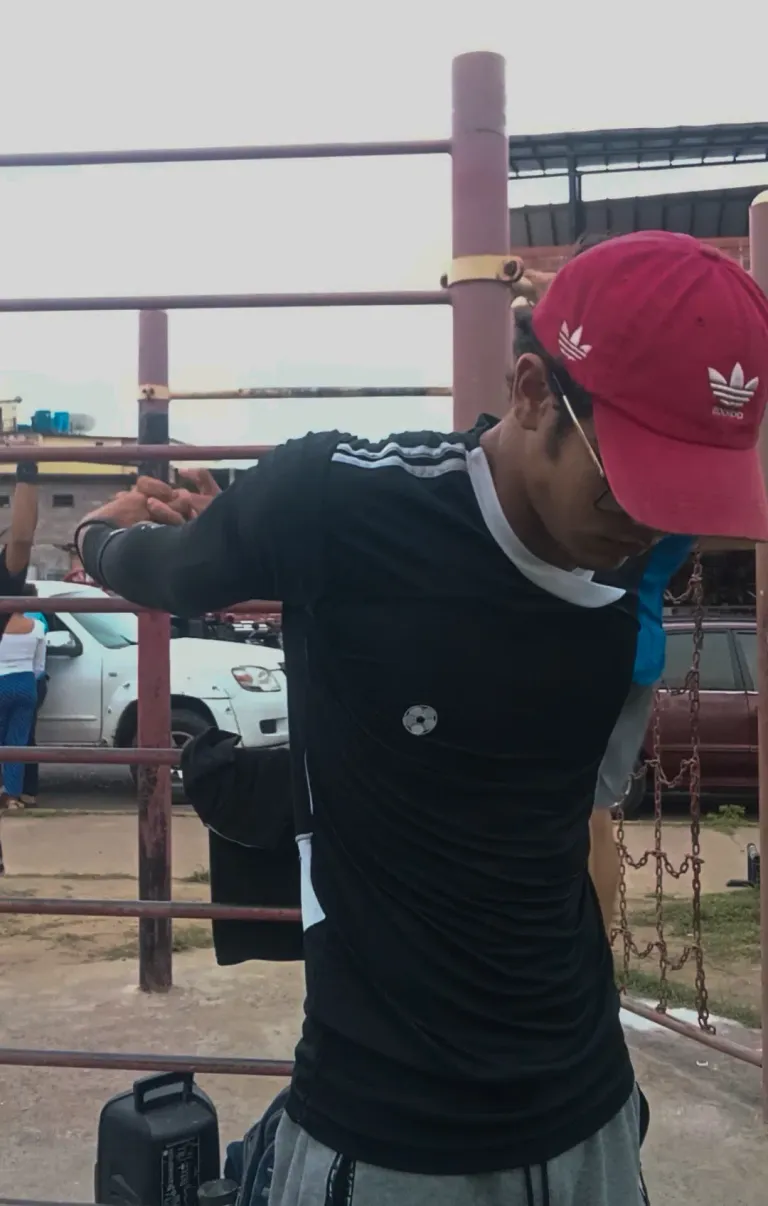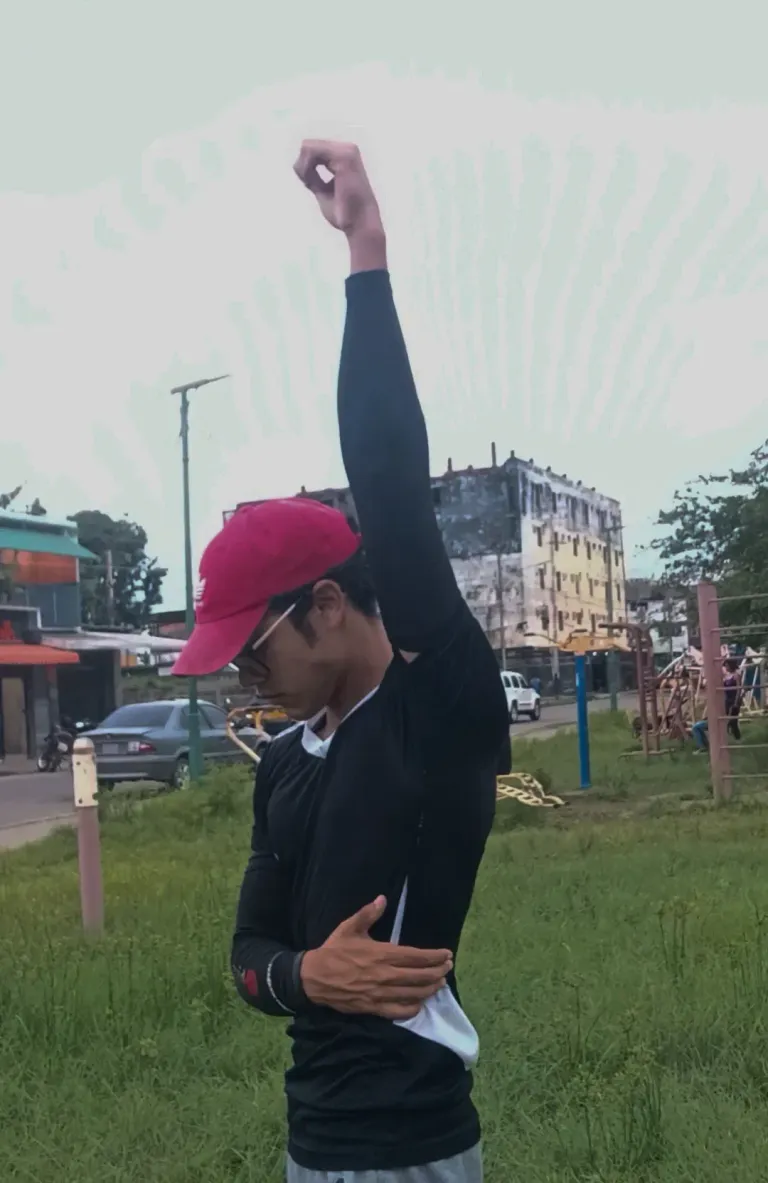





Street Workout Community |
|---|
La Importancia De La Biomecánica Para Un Calentamiento Excepcional
Buenos días, buenas tardes y buenas noches amigos de
Hive, LikeTu
y compañeros de Street Workout
Community. Como están hoy? Espero que de lo mejor, está vez les estaré hablando un poco sobre la biomecánica y la gran ventaja que nos da en el deporte al tener conocimiento de ella.
Cómo ya han visto, el día de hoy me base más que todo en trabajar mis calentamientos aplicando los conocimientos que he aprendido sobre la biomecánica del hombro principalmente, ya que a veces suelo tener problemas con este mismo y por eso suelo trabajar mucho en mi flexibilidad. Está vez, no inicie mi camino a pie, si no que un amigo mío se ofreció a llevarme a la plaza de las maracas y sin ningún problema acepte. Al llegar al parque me tomé un ligero descanso para después empezar con unos estiramientos aplicando los conocimientos básicos en la biomecánica del hombro, como lo es la Flexion, extensión, rotación interna, rotación externa, abducción, aducción y circunduccion. La flexión reduce el ángulo entre dos articulaciones adyacentes, como al doblar un codo o brazo hacia adelante. La extensión estira o alarga una articulación, como al levantar el brazo por encima de la cabeza. La rotación interna hace girar una articulación hacia el interior del cuerpo, como cuando se gira el brazo hacia adentro. La rotación externa hace girar una articulación hacia afuera y hacia atrás, como cuando se gira la cabeza hacia un lado. La abducción se refiere al movimiento de desplazar una extremidad lejos del eje longitudinal del cuerpo, como cuando se abre un brazo hacia un costado o se extiende una pierna hacia un costado. La aducción se refiere al movimiento contrario a la abducción, en el que se desplaza una extremidad hacia el eje longitudinal del cuerpo y se acerca a una posición central, como cuando se lleva un brazo o una pierna hacia el cuerpo. La circunducción se refiere al movimiento de desplazar una articulación en un círculo completo. Por ejemplo, cuando se gira la muñeca de lado a lado en un círculo completo, o cuando se mueve el brazo alrededor del hombro en un círculo completo. La circunducción permite un movimiento de rotación completa y es importante para actividades como lanzar una pelota o girar un volante. conocimientos en los cuales tengo más entendimiento gracias a la escuela en la que asistía. El día de hoy me dedique a hacer la mayoría de estos con estiramientos y movimientos estaticos, dinámicos, pasivos y activos aunque no he fotografiado el proceso en su totalidad. Siguiendo con el tema, de seguro algunos se podrían estar preguntando ¿Que tipos de estiramientos son esos? Pues para su información estos tipos de estiramientos son muy importantes para diferentes propósitos y momentos durante cualquier rutina de ejercicio y entrenamiento, estos estiramientos nunca faltan en mis rutinas para así poder evitar el más mínimo riesgo de lesión. A continuación, les estaré hablando aún más sobre este tipo de estiramientos, para así poder explicarles esta información de una manera correcta y sencilla.
Los Estiramientos Estáticos:
Los estiramientos estáticos son técnicas de estiramiento donde se tiene que mantener una posición estática durante un período de tiempo específico para lograr elongar los músculos y mejorar la flexibilidad. A diferencia de los estiramientos dinámicos, no se utilizan movimientos activos durante los estiramientos estáticos, ya que se busca mantener la posición más tiempo posible para lograr una mayor relajación muscular y una mayor elongación. Los estiramientos estáticos generalmente se utilizan al final de una rutina de ejercicio o entrenamiento para favorecer el estiramiento muscular y promover la relajación.Los Estiramientos Dinámicos:
Los estiramientos dinámicos son técnicas de estiramiento las cuales involucran movimientos suaves y controlados con el fin de aumentar la temperatura muscular, mejorar el rango de movimiento articular y preparar los músculos para un ejercicio o actividad física más intenso. A diferencia de los estiramientos estáticos, los estiramientos dinámicos utilizan el movimiento para estirar los músculos y tendones de forma activa, lo que los hace más adecuados para ser utilizados como parte de un calentamiento previo a un entrenamiento o actividad física.Los Estiramientos Pasivos:
Los estiramientos pasivos son técnicas de estiramiento en las que se tiene que mantener una posición estática durante un período de tiempo para lograr una elongación muscular. En los estiramientos pasivos, generalmente se requiere la ayuda de una persona externa o de algún objeto para mantener la posición, ya que la persona al realizar este estiramiento debe estar relajada y no realizar ningún esfuerzo muscular activo para mantener la posición. Estos estiramientos se utilizan para poder mejorar la flexibilidad y el rango de movimiento de las articulaciones, reducir la tensión muscular y el estrés, y promover la relajación y el bienestar general.Los Estiramientos Activos:
Los estiramientos activos son técnicas de estiramiento en las que se utilizan los propios músculos para extender el rango de movimiento articular y mejorar la flexibilidad. En los estiramientos activos, el individuo realiza movimientos controlados y conscientes para estirar los músculos y las articulaciones, lo que a menudo se diferencia de los estiramientos pasivos en que no se requiere la ayuda de una persona externa o un objeto inanimado para mantener una posición estática durante un tiempo prolongado.Espero que está información les sea de mucha ayuda a la hora de realizar cualquier tipo de ejercicio o entrenamiento y en querer mejorar sus rutinas en un futuro. La verdad, hablar de este tema es algo que me da mucha emoción ya que uno de mis sueños es poder ampliar este tipo de conocimiento para que algún día tenga mi propio consultorio de fisioterapia para así poder atender a varios atletas ya sean de calistenia o de algún otro deporte.
Espero que lo hayan disfrutado, nos volveremos a ver muy pronto.
The Importance Of Biomechanics For An Exceptional Warm-Up
Good morning, good afternoon and good evening friends from
Hive, Liketu
and colleagues of Street Workout
Community. How are you today? I hope the best, this time I will be talking a little about biomechanics and the great advantage it gives us in sport to have knowledge of it.
As you have already seen, today I based myself more than anything in working my warm-ups applying the knowledge I have learned about the biomechanics of the shoulder mainly, because sometimes I usually have problems with it and that's why I usually work a lot on my flexibility. This time, I didn?t start my way on foot, but a friend of mine offered to take me to the maracas square and without any problem I accepted. When I got to the park I took a short break and then I started with some stretches applying the basic knowledge of shoulder biomechanics, such as flexion, extension, internal rotation, external rotation, abduction, adduction and circumduction. Flexion reduces the angle between two adjacent joints, such as bending an elbow or arm forward. Extension stretches or lengthens a joint, as in raising the arm overhead. Internal rotation rotates a joint inward toward the inside of the body, as when turning the arm inward. External rotation rotates a joint outward and backward, as when turning the head to the side. Abduction refers to the movement of moving a limb away from the longitudinal axis of the body, such as opening an arm out to the side or extending a leg out to the side. Adduction refers to the opposite motion of abduction, in which a limb is moved toward the longitudinal axis of the body and approaches a central position, as when an arm or leg is brought toward the body. Circumduction refers to the movement of moving a joint in a full circle. For example, when turning the wrist from side to side in a full circle, or when moving the arm around the shoulder in a full circle. Circumduction allows a full rotational movement and is important for activities such as throwing a ball or turning a steering wheel. knowledge in which I have more understanding thanks to the school I attended. Today I went through most of these with static, dynamic, passive and active stretches and movements although I have not photographed the process in its entirety. Continuing with the topic, surely some of you might be wondering what types of stretches are those? Well for your information these types of stretches are very important for different purposes and moments during any exercise and training routine, these stretches are never missing in my routines in order to avoid the slightest risk of injury. Next, I will be telling you even more about these types of stretches, so I can explain this information in a correct and simple way.
The Static Stretches:
Static stretching is a stretching technique where a static position must be held for a specific period of time in order to elongate muscles and improve flexibility. Unlike dynamic stretching, no active movements are used during static stretching, as the aim is to hold the position as long as possible to achieve greater muscle relaxation and elongation. Static stretches are generally used at the end of an exercise or training routine to encourage muscle stretching and promote relaxation.The Dynamic Stretching:
Dynamic stretches are stretching techniques which involve gentle, controlled movements in order to increase muscle temperature, improve joint range of motion and prepare muscles for more intense exercise or physical activity. Unlike static stretches, dynamic stretches use movement to actively stretch muscles and tendons, making them more suitable for use as part of a warm-up prior to a workout or physical activity.The Passive Stretching:
Passive stretches are stretching techniques in which a static position must be maintained for a period of time in order to achieve muscle elongation. In passive stretching, the help of an external person or some object is generally required to maintain the position, since the person performing this stretching must be relaxed and not make any active muscular effort to maintain the position. These stretches are used to improve flexibility and range of motion of the joints, reduce muscle tension and stress, and promote relaxation and general well-being.The Active Stretching:
Active stretches are stretching techniques in which the muscles themselves are used to extend joint range of motion and improve flexibility. In active stretching, the individual performs controlled, conscious movements to stretch the muscles and joints, which often differs from passive stretching in that no assistance from an outside person or inanimate object is required to maintain a static position for an extended time.I hope this information will be of great help when it comes to perform any type of exercise or training and want to improve their routines in the future. The truth is, talking about this topic is something that gives me a lot of excitement because one of my dreams is to expand this type of knowledge so that someday I can have my own physiotherapy office to be able to attend to various athletes, whether they are calisthenics or some other sport.
I hope you enjoyed it, we'll see you again very soon.



For the best experience view this post on Liketu

Saludos @javier-17h
Greetings @javier-17h
Congratulations @javier-17h! You have completed the following achievement on the Hive blockchain And have been rewarded with New badge(s)
Your next target is to reach 1500 upvotes.
You can view your badges on your board and compare yourself to others in the Ranking
If you no longer want to receive notifications, reply to this comment with the word
STOP